From Daytona to Rolex Cosmograph Daytona : a passion for speed
Created by Rolex in 1963, this legendary model has established an extraordinary track record in the world of motor racing thanks to its reliability and performance. Known simply as the “Daytona”, it has risen to the rank of an icon as the most famous and most coveted chronograph in the world.
Before lending its name to one of Rolex’s most emblematic models, the city of Daytona, Florida with its famous long straight beach, forged its own legend as the capital of land speed records from 1903. Daytona, the place and the watch, today speak volumes about the long-standing and privileged ties that bind Rolex and automobile racing, whether in endurance or speed.
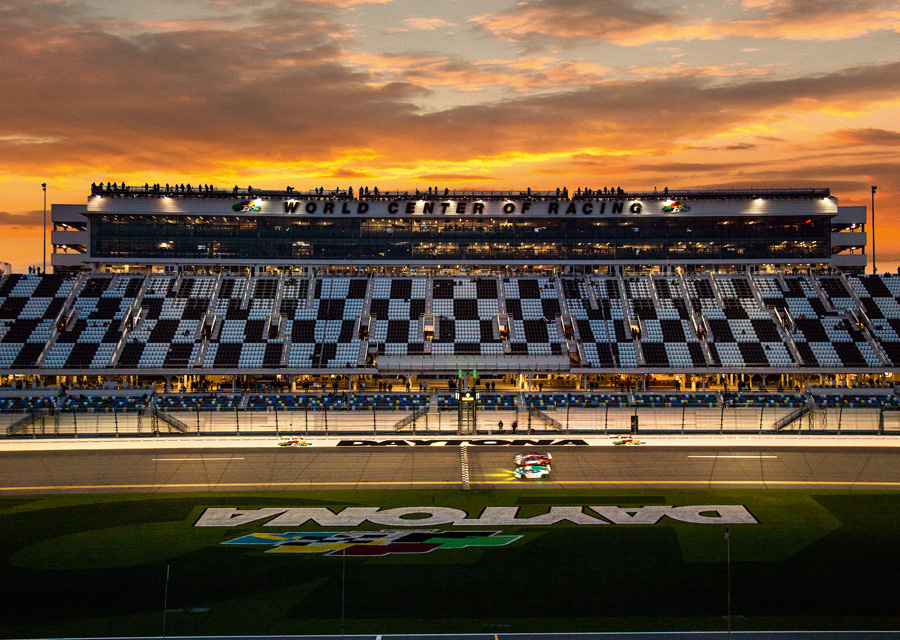
This exciting story, which is without parallel, is the focus of the three chapters of this press kit – the place, the watch, the legend: a story of man and machine told through technological development and innovation, adrenalin and drive, passion and the determination to push the limits.
THE PLACE
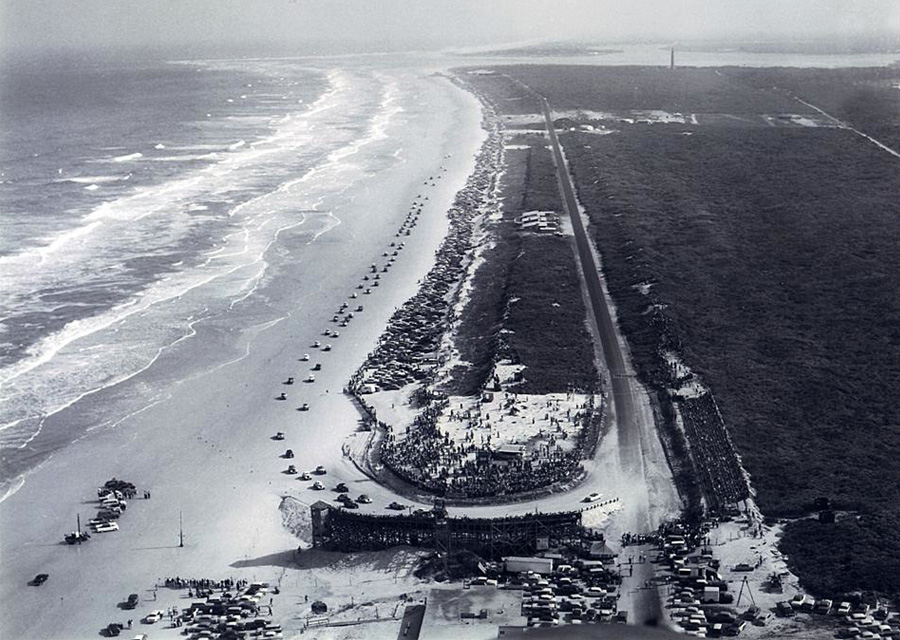
The city of Daytona beach, Florida, has gone down in history as the birthplace of speed. Motor racing took place on its beach from 1903, and many world land speed records were broken there, the most significant culminating at 276 MPH (445 KM/H) in 1935. In the United States today, Daytona beach is still considered the “world centre of automobile racing”. From its headquarters there, the international speedway corporation oversees 13 american racetracks including the legendary Daytona International Speedway. Daytona also hosts the governing bodies of Nascar and Grand-Am.
1903 – 1935 THE KINGS OF SPEED
From 1903 to 1935, the hard-packed sand beach in Daytona, Florida became famous worldwide as the perfect place to beat speed records. No fewer than 80 official records were set there, 14 of which were for the fastest speed in the world. A sign at the location of the measured mile – a mile marked on the sand that served as a gauge to calculate the speed of the racers – listed, at the time, several of the most famous feats. They included those of W. K. Vanderbilt in 1904, who at 92 mph (148 km/h) set the first world record in Daytona, and Barney Oldfield and his Lightning Benz, who was anointed the king of speed in 1910 at 131 mph (210 km/h). After setting his record, Oldfield declared his speed to be “as near to the absolute limit of speed as humanity will ever travel”.
Ralph DePalma, one of the greatest race drivers of his time, set a new world record at the wheel of his powerful 12-cylinder Packard in 1919 at 149 mph (240 km/h) – a record that would stand unbeaten for more than 10 years. Then came the era of the two most formidable rivals in the history of the conquest of speed: Malcolm Campbell and Henry Segrave. These two wealthy Englishmen, who would later both be knighted by King George V for their speed records, began to compete against each other in the 1920s on the Brooklands race track in England, opened in 1907 as the first purpose-built racing circuit in the world. When their ever more powerful cars became too fast for the concrete oval at Brooklands, they turned to the beaches, first at Pendine Sands and Southport in England, then, inevitably, at Daytona. Each one built in secret a vehicle capable of exceeding 200 mph (321 km/h), a speed reached only by aeroplanes at the time.
Their cars, constructed for races in a straight line on the beach, were equipped with aircraft engines. Segrave won the first Daytona encounter in 1927 driving his Sunbeam Mystery S, reaching 203 mph (328 km/h). This was the first record certi?ed according to international standards, by calculating the average speed of two runs in opposite directions on a measured mile in order to compensate for the wind effect. Campbell raised the bar the following year with Bluebird – the name he gave to all his cars – at 207 mph (333 km/h). In 1929 Henry Segrave took the lead again at 231 mph (372 km/h) with his new race car Golden Arrow, a world record that earned him his knighthood and a place on the front page of the New York Times. Tragically, he died a year later in an accident while trying to break the record for speed on water.
Campbell then became the uncontested king of speed, beating year after year his own world records in Daytona with ever more powerful versions of Bluebird. His exploits attracted thousands of people, as well as the press from all over the planet, to Daytona Beach. In March 1935, aiming for 300 mph (482 km/h), he hit 330 mph (531 km/h) on his first pass – the highest speed ever reached in Daytona – but problems on the run in the opposite direction reduced the average speed of his official record to 276 mph (445 km/h).
This was the last record set on the beach in Daytona. Campbell’s disappointment prompted him to test a new site, the Bonneville Salt Flats in Utah. In September of the same year, he succeeded in meeting the challenge and set his ultimate official record at 301 mph (483 km/h). Since 1930, Campbell had been wearing a Rolex OYSTER, the watch on his wrist during the exploit. He attested to its exceptional resistance to shocks and vibrations – without ever accepting any remuneration from Rolex, as mentioned in the advertisements of the time. Thus, the first Rolex Testimonee in motor sport was already closely tied to Daytona.
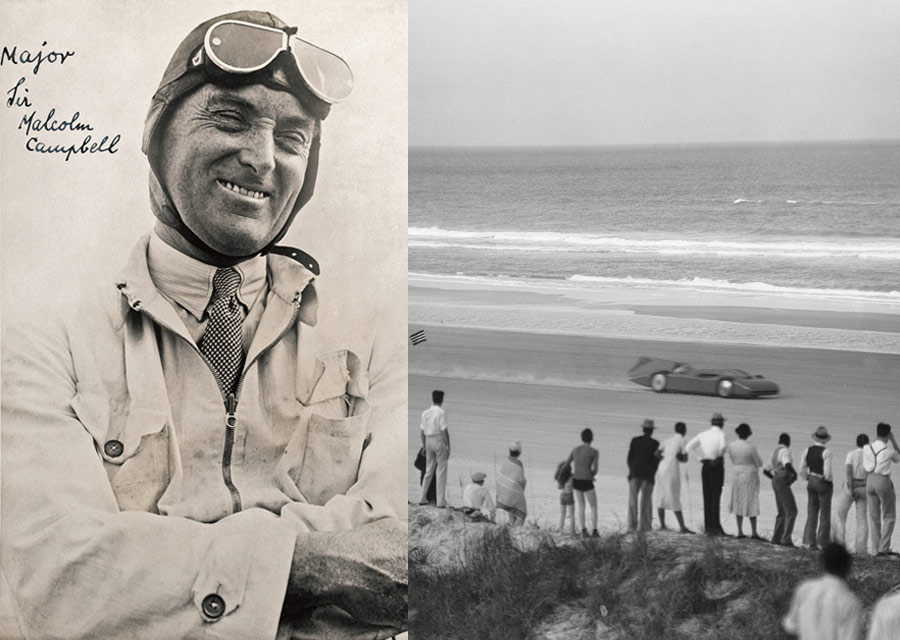
“Daytona Beach, Florida is the only place I know where it is possible to make world land speed records. The sand packs almost as hard as cement, and there is suffcient length to get up speed.” Sir Malcolm Campbell, world land speed record breaker, May
1932 1936 – 1959 A SAND TRACK UNIQUE IN THE WORLD
The beach in Daytona did not end its romance with motor sport after the attempts to set land speed records moved to Utah. As of 1936, races that were unique in the world were held there, allowing Daytona to maintain its status in automobile racing. Soon came the golden age of stock car races on an oval track. Half of it was on the beach and half on a narrow road parallel to the ocean. From 1937, this unlikely race track also attracted the 200-mile American motorcycle championship, which became a classic under the name Daytona 200. The races on the beach were extremely spectacular and followed by hundreds of spectators. Soon wooden grandstands were erected alongside the turns on the sand where some competitors became bogged down, when they did not end up in the ocean.
From this tradition NASCAR (National Association for Stock Car Racing) was born in 1948 in Daytona. Today NASCAR races are held in the four corners of the United States in what has become one of the categories of motor racing most followed by the American public. That same year, the Speed Weeks created in Daytona in the early 20th century were reborn. For two weeks, generally in February under the Florida sun, the beach in Daytona once more became the nerve centre of automobile sport in the United States. A measured mile on the beach allowed the organization of speed contests again, in which all makes of American cars and prestigious European sports car brands took part in order to promote their most recent models.
The cars gained momentum over several kilometres to reach the highest possible speed as they arrived in the measured mile. These competitions were also open to the public: each driver was allowed to try to set an of?cially certified speed record in his own car. Epic motorcycle and car races on the famous Daytona Beach-Road Course, between road and beach at low tide, were the highlight of the Speed Weeks. Legend has it that a large number of the best drivers had been involved in contraband alcohol traditionally distilled in the Appalachian mountains in the south-eastern United States (Georgia, North and South Carolina in particular) and were highly experienced racers because they were accustomed to evading the federal agents who regularly chased after them.
In the mid-1950s, urban development and the deterioration of the sand began to threaten competitions on the beach. The president and founder of NASCAR, William France Sr, launched an ambitious construction project for a permanent, hard-surface race track for the speed races: the Daytona International Speedway. It was inaugurated in 1959 to perpetuate Daytona’s unique heritage and worldwide fame.
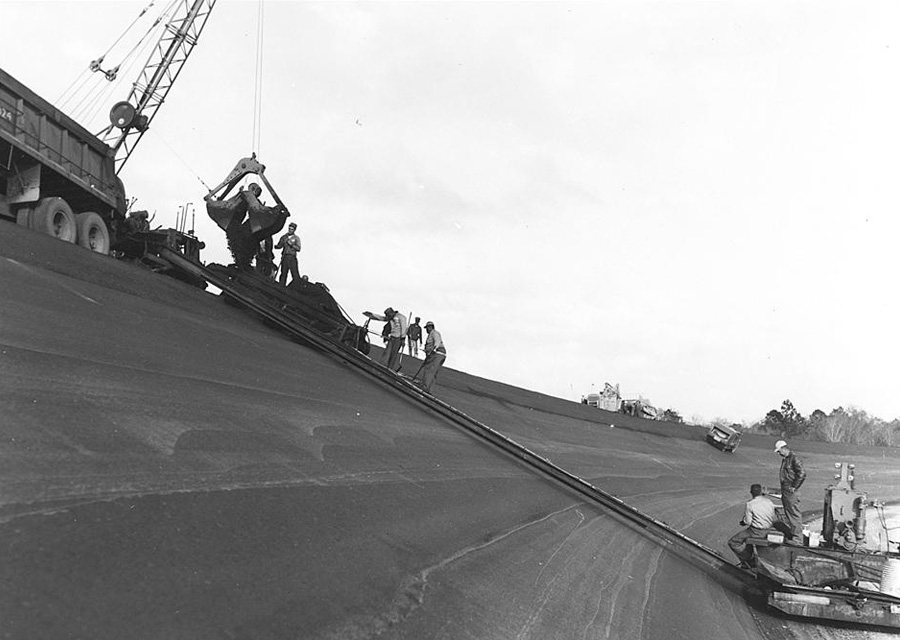
1959-2013 – A TEMPLE OF MOTOR RACING
When it was inaugurated in 1959, the Daytona International Speedway was the fastest racing circuit in the United States, and one of the first Super Speedways in the world. The tri-oval shape and dimensions of this 2.5-mile (4 km) circuit still impress anyone who enters the grounds. Its unusual design is all about speed with a 31-degree banking in the turns, more than 10 metres high at its tallest point. The high banking allows cars to approach the turns at great speed without skidding off the track due to centrifugal force, and offers spectators a good view of the race from any seat in the grandstands. But the construction work revealed major engineering challenges, not ably to pave the surface. The project engineer, Charles Monneypenny, developed a unique technique for laying asphalt in the banked turns. The paving machines were connected to bulldozers anchored at the top of the turns to allow them to work on the sloped surface. This patented technique would later be used to build other race tracks.
The design of the Daytona International Speedway is unique in other ways: from the beginning, its founder, William France Sr, wanted to make the new track more than just the most important venue for NASCAR races. He also wanted it to be a reference internationally. And the way to attract the best racing drivers in the world to Daytona was to organize races in the category then considered as the elite of motor sport: sports cars. William France Sr invented a revolutionary concept by building a road racing course on the infield of the giant speedway to host sports car and motorcycle races, combining a classic track and a unique oval with banked turns.
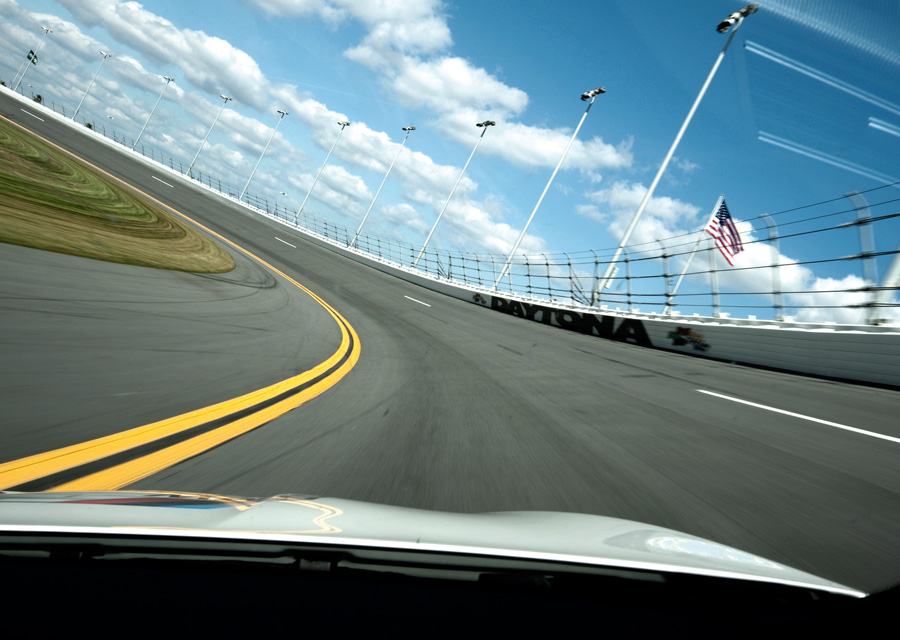
This innovative approach brought about the race that would become the Rolex 24 At Daytona, one of the most prestigious endurance races in the world alongside the 24 Hours of Le Mans. It gave the American race track its international status. The first edition, under the name “Daytona Continental”, took place in 1962, just one year before the launch of the Rolex Cosmograph Daytona. The race and the watch were practically contemporaries and their destinies would soon become inextricably linked.
William France Sr, a great admirer of Sir Malcolm Campbell, also wore a Rolex. He appeared in an advertisement for the brand in the early 1960s mentioning Rolex as the Official Timepiece of the Daytona International Speedway. From the first editions of the Daytona Continental, the champion driver won a Rolex watch in addition to the trophy. When the Cosmograph, designed for racing drivers, was introduced, it naturally became the supreme prize awarded to the winner. And not long afterwards, to emphasize the brand’s connection to the American race track, Rolex named the model the Cosmograph Daytona.
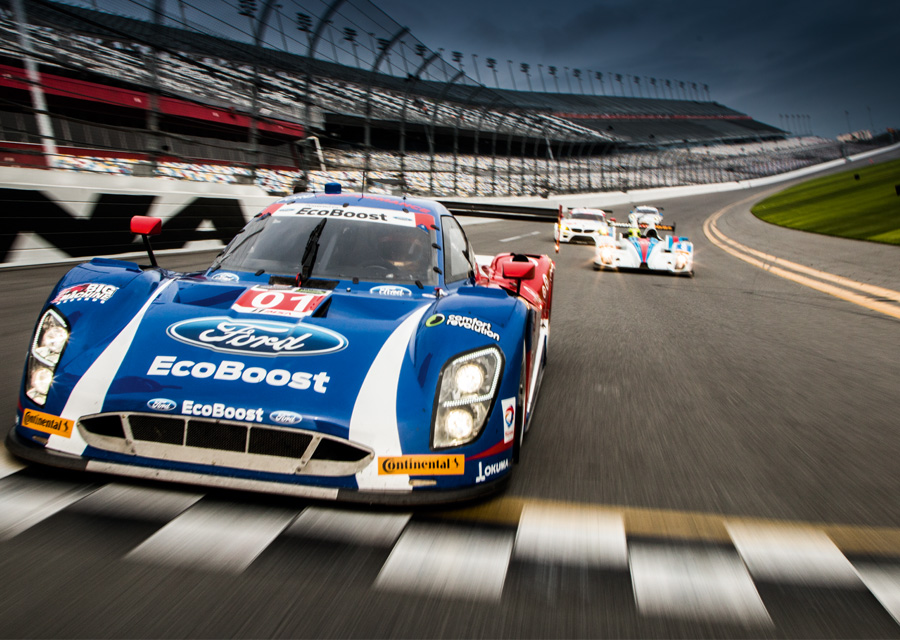
In 1992, Rolex became the Title Sponsor of the 24 Hours of Daytona, making of?cial an association that had already become legendary. Ever since then it has been called the Rolex 24 At Daytona. The longest and most prestigious race in the United States, this event marks the opening of the international motor sport season and is known by everyone as “The Rolex”. Crowds traditionally abandon the grandstands to occupy the vast space in the in?eld in a particularly festive atmosphere. In 2012, this legendary race celebrated its 50th anniversary – just one year before that of the Cosmograph Daytona in 2013. The anniversary edition was marked by a record attendance – and an epic finish. The winning team won with a lead of only 5 seconds after 24 hours of close racing, measured with precision by the official Rolex clock near the finish line. In the end, the winners covered a distance of 2,672 miles (4,300 kilometres), the equivalent of crossing the United States from New York to Los Angeles.
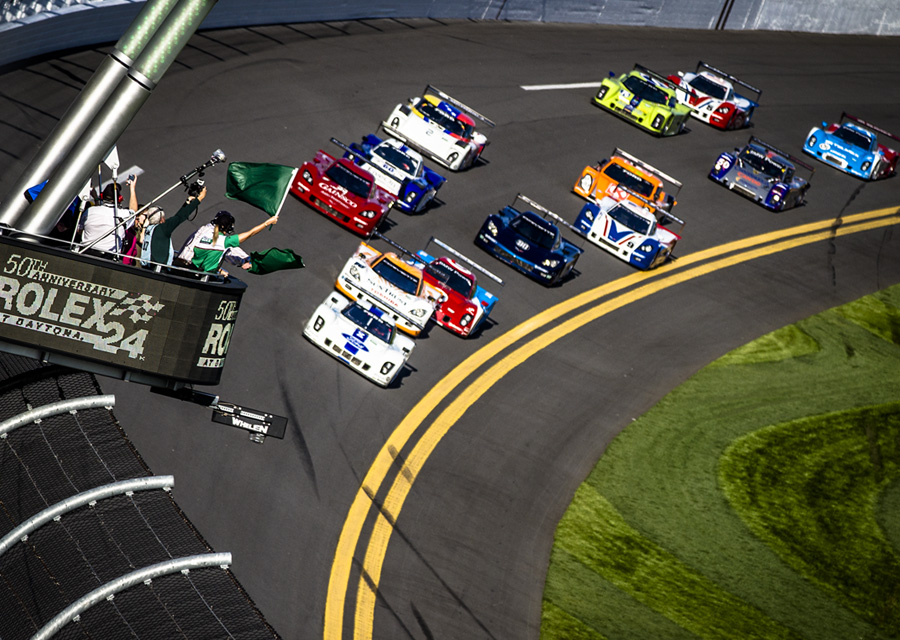
Captivating, spectacular and extremely demanding, the Rolex 24 At Daytona is the only top-level sports car race in the world, besides the 24 Hours of Le Mans, which tests the ultimate limits of man and machine for a complete 24-hour cycle. Today as in the past, the drivers who take part in this race – many of whom come from the worlds of F1, NASCAR, IndyCar and endurance racing – dream of being able to wear a Daytona thanks to an achievement that would earn universal respect: winning it.
THE WATCH
The Oyster Perpetual Cosmograph Daytona is the consummate Rolex chronograph. Efficient, precise, legible, robust, reliable, waterproof and self-winding, it is also comfortable, elegant, timeless and highly prestigious. Judging by the success and outstanding reputation worldwide of this peerless alchemy of form and function, it is considered in many respects to be the ultimate chronograph. Fifty years after its launch in 1963, this embodiment of perfection is the product of a long maturation process. Each inscription on the dial of a Rolex watch is a guarantee of performance; on this emblematic model, they were added one by one as the watch evolved. Solely “Cosmograph” at the outset, over the years “Oyster”, “Perpetual”, “Cosmograph”, “Daytona” and “Superlative Chronometer Officially Certified” were added, chronicling a legend in watchmaking.
1963 – COSMOGRAPH, THE CHRONOGRAPH OF THE FUTURE
In 1963, Rolex launched a new-generation chronograph, the Cosmograph, dedicated to racing drivers. The singular name invented by Rolex immediately marked it out as a very different new model with an equally innovative style. The chronograph counters stood out clearly on the dial thanks to their strongly contrasting colour: black on a light coloured dial or light coloured on a black dial. The tachymetric scale – a graduation allowing the measurement of average speeds over a given distance using the chronograph seconds hand – was moved from the dial to the circumference of the bezel, opening up and simplifying the dial.
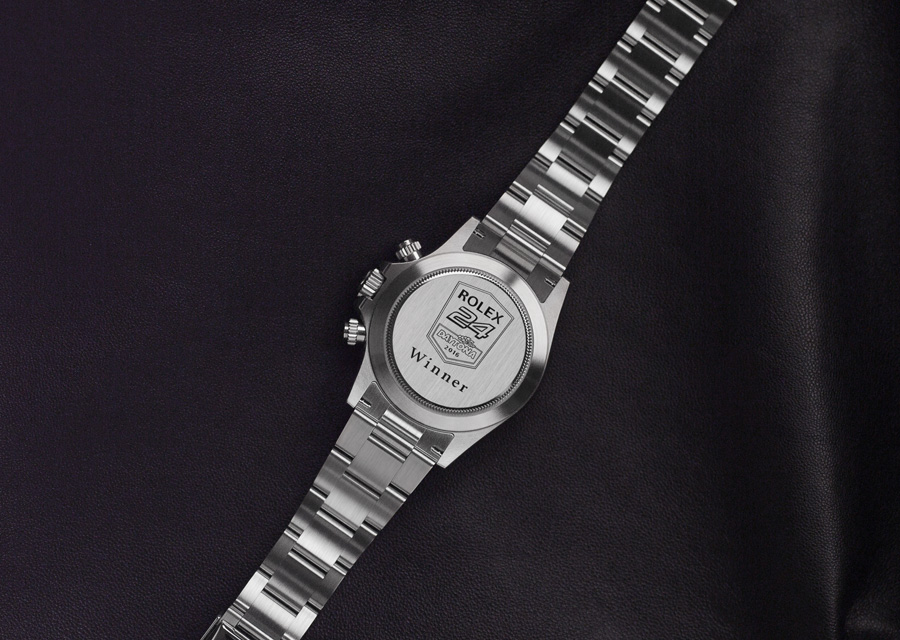
Dictated by functional considerations, as is usually the case at Rolex, these features made the chronograph functions far more legible – one of the challenges of the time. They also gave the watch a technical and sporty look making it instantly recognizable. The Cosmograph clearly deserved its place among the Professional watches, a category created by Rolex 10 years previously, in 1953, with models such as the Explorer dedicated to explorers and mountaineers, or the Submariner specially designed for deep-sea diving.
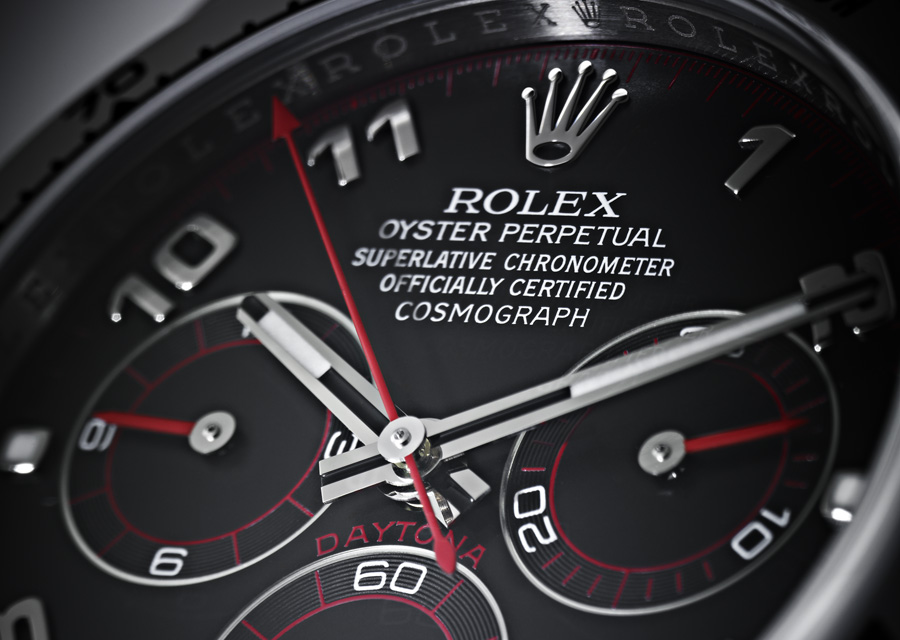
New dials were introduced, expanding the range in the early years. One special version would become famous as the so-called “Paul Newman” dial, since the renowned American film star – who was also a racing driver and an icon of masculine style – regularly wore a Daytona with that particular dial. The design of his favourite dial increased legibility of the chronograph functions under difficult race conditions. It was characterized by the seconds track around the dial on a band of the same contrasting colour as thethree counters. The graduations, in certain cases, were inscribed in red. The counters themselves were differentiated by squares on the markers to facilitate reading.
The Cosmograph was part of a long Rolex trad ition in chronographs. The brand launched its first models with counters in 1933, which were often equipped with other functions on the dial such as a tachymetric scale for measuring speed, a telemetric scale to track distance, or a pulsometer to measure heart rate. The First chronograph equipped with a waterproof Oyster case appeared in 1939.
From its launch, the Cosmograph featured the Oyster case invented by Rolex in 1926 – robust and waterproof thanks to the screw-down case back and winding crown – as well as a solid metal bracelet. The watch also featured a manually wound mechanical movement reputed for its reliability and precision. No brand had yet been able to overcome the technical hurdle of producing a self-winding chronograph.
1965 – BLACK BEZEL AND SCREW-DOWN PUSHERS
The Cosmograph evolved in 1965 with the launch of a version that introduced screw-down chronograph pushers instead of the pump pushers found on the original model. The screw-down pushers brought the finishing touch to the Oyster concept, and prevented the pushers from being manipulated accidentally. In testimony to its reinforced waterproofness, the name “Oyster” was inscribed on all the dials in addition to “Cosmograph”. Another new feature came in the form of a black Plexiglas insert for the tachymetric bezel. The white graduation increased legibility yet again.
An additional inscription appeared on some dials during the new Rolex chronograph’s early years on the market: Daytona. Initially limited to watches for the American market, it was most probably added at the request of the Rolex affiliate in the United States to mark the brand’s link, as Official Timepiece, with the Daytona International Speedway in Florida, and to symbolize the model’s close connection with the world of motor racing. The name gradually began to be inscribed on every Cosmograph dial, finally taking on its current form in an arc with red lettering above the counter at six o’clock.
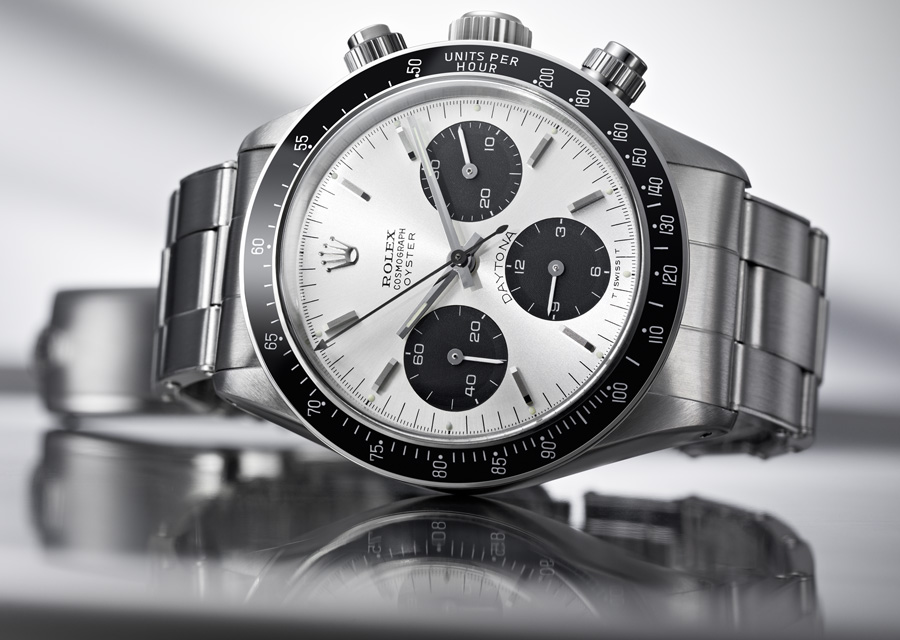
Rolex’s chronograph, the Oyster Cosmograph Daytona, also became available in an 18 ct yellow gold version, certified as a chronometer. And these gold versions bore the fam ous phrase “Superlative Chronometer Officially Certified” on their dial, a rare achievement for a chronograph.
1988 – SELF-WINDING MOVEMENT AND SUPERLATIVE CHRONOMETER
With the arrival of quartz movements in the 1960s–1970s, Rolex nevertheless remained faithful to the mechanical watch and to the Cosmograph Daytona, preparing its future evolution. In 1988, the Daytona became self-winding. The brand opted for a quality, commercially available chronograph movement, which it then significantly modi?ed to meet its own requirements, replacing more than 50 per cent of the components with parts specifically designed for Rolex Daytona movements.
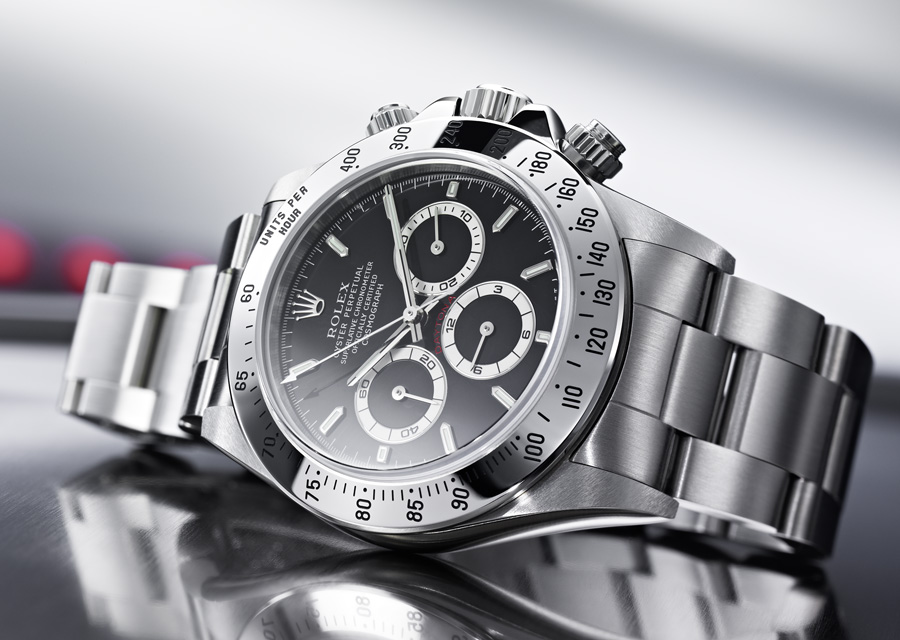
The resulting new calibre 4030 included, among other features, a Rolex “heart” – an oscillator with a variable inertia balance wheel, Microstella regulating nuts and a hairspring with a Breguet overcoil – as well as a self-winding module with a Perpetual rotor invented by the brand in 1931. The movement was systematically submitted for official certification to receive the designation of chronometer, attesting to its superior precision. All versions of the new model featured the phrase “Superlative Chronometer Officially Certified” on their dial as well as “Oyster Perpetual Cosmograph Daytona”.
The model’s update went far beyond technical features. The redesigned aesthetics formed the basis of the Cosmograph Daytona’s imposing and elegant appearance today. The diameter of its Oyster case was increased from 36 to 40 mm and included shoulders to protect the crown. The tachymetric bezel in metal was made wider and engraved with a 400-unit graduated scale. New hands, new hour markers, new counters within banded circles: the dial was modernized, while preserving its inimitable style and its signature “Daytona” in red letters.
The new model met with great success, owing to a surge of renewed interest during the early 1990s for mechanical watches generally and chronographs in particular – a phenomenon to which the Daytona itself very probably contributed. It was seen on the wrists of a number of personalities, not only in the car racing world, but also in political and economic circles and in the arts. Given this context, the model’s rarity on the market only fuelled its desirability and created demand that was previously unknown in watchmaking history, and which has not diminished in 25 years.
2000 – A NEW CHRONOGRAPH STANDARD
As a backdrop to the launch of an entirely new interpretation
of the Cosmograph Daytona, it is difficult to imagine an event more symbolic than entering a new millennium. The new model introduced by Rolex in the year 2000 – like the irst Cosmograph in its time – embodied the chronograph of the future.
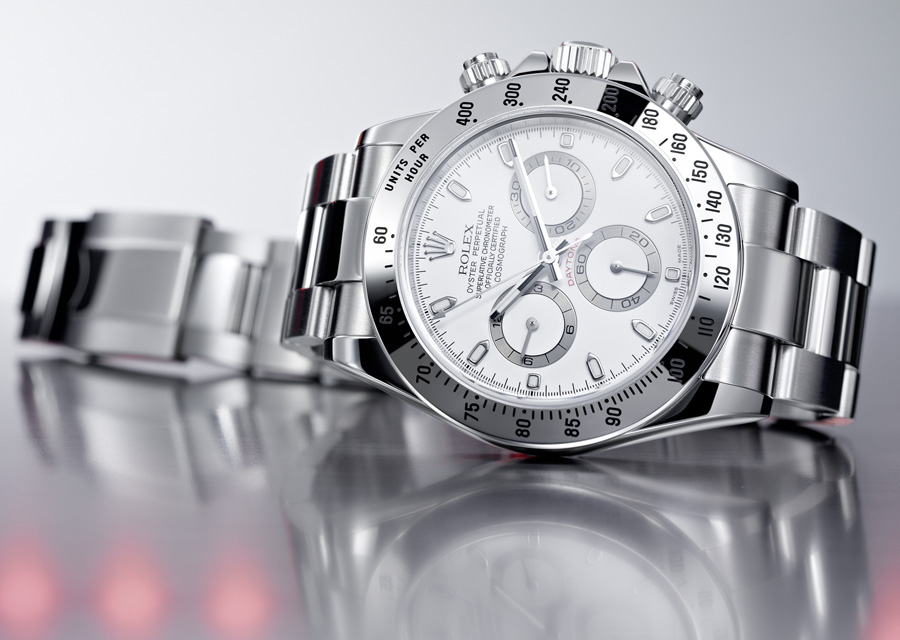
Its aesthetics remained deliberately faithful to the codes of the 1988 Cosmograph Daytona, perfecting the iconic and distinctive design of the original, and its subtly sculpted strong lines and balanced ergonomics. In 1963 the Rolex chronograph had innovated with radically new aesthetics that enhanced the legibility of its functions. However, the innovations in the Oyster Perpetual Cosmograph Daytona for the new millennium essentially lie inside the case.
This model has a new-generation self-winding chronograph movement – calibre 4130 – specially designed for the Cosmograph Daytona and entirely manufactured in-house. A masterpiece of engineering and micromechanics, replete with innovative and patented technical solutions, this high-performance movement has set a new standard for luxury self-winding chronographs in terms of robustness, reliability, efficiency and precision, as well as for ease of maintenance.
Calibre 4130’s performance stems particularly from the use of a vertical clutch to activate the chronograph function, instead of the traditional lateral clutch. This new solution functions on the principle of two discs one above the other which work together by direct friction contact and offers signi?cant advantages – extremely precise starting and stopping of the perfectly smooth running chronograph seconds hand as soon as the pusher is pressed; and the ability of the chronograph to function for long periods of time with no negative impact on the precision of the watch.
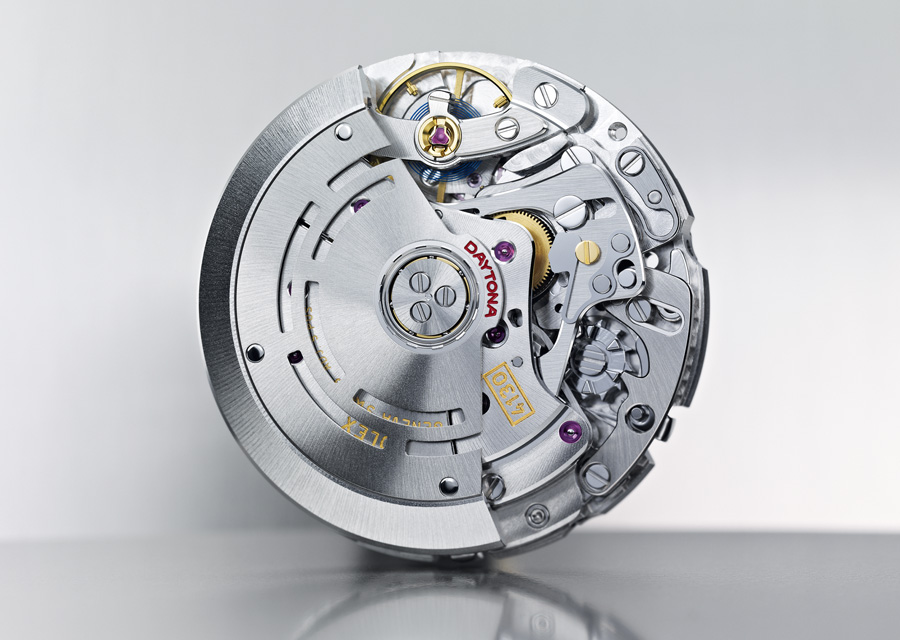
With calibre 4130, Rolex engineers managed to reduce the number of components for the chronograph mechanism by 60 per cent. They particularly simplified the minute and hour counter systems – traditionally two distinct mechanisms situated on each side of the movement – by integrating them into a single module judiciously placed on one side of the movement with an off-centre clutch. A patented solution which reduces from five to one the number of adjustments by excentric screws required to regulate the chronograph. It also saves space, making it possible to house a larger mainspring and thereby extend the power reserve to 72 hours, instead of the previous 50. The mainspring, the power-house of the watch, can be replaced without the whole movement having to be disassembled, thanks to the independent self-winding module which is easily removed to access the barrel. Additionally, the efficiency of the self-winding mechanism has been substan- tially enhanced, notably with a system of new-generation reversing wheels that allow more efficient bidirectional winding.
The oscillator, the strategic heart of the watch and guarantor of its precision, also took advantage of telling innovations. A larger balance wheel, equipped with the
Rolex micrometric regulating system via Microstella nuts, contributes to the movement’s precision. In keeping with the architecture of Rolex calibres, it is held in place by a traversing balance bridge, fixed at both sides to improve resistance to shocks and vibrations. But one of the most spectacular developments introduced on the oscillator of the new Cosmograph Daytona is the Parachrom hairspring. Developed, patented and entirely manufactured by Rolex in an alloy of niobium, zirconium and oxygen, the Parachrom hairspring has exceptional qualities that greatly increase the movement’s precision by significantly enhancing its resistance to perturbation. It is also insensitive to magnetic fields, extremely stable in the face of temperature variations and is unaffected by the thousands of small shocks a watch is subjected to in daily wear. It remains up to 10 times more precise than a traditional hairspring.
The new calibre 4130 was also the first Rolex calibre to have its name engraved on the oscillating weight: a curving “Daytona” in red letters echoing the name on the dial. Two details on the dial show that the watch was fitted with the new movement. First, the horizontal positioning of both chronograph counters – the small-seconds was moved from its usual position at 9 o’clock to the bottom of the dial at 6 o’clock. Secondly, the minute and hour counters are aligned slightly above the centre of the dial, an aesthetic signature that enhances the visual balance of the dial and underlines the meticulous attention to detail so typical of Rolex. Contrary to its predecessors, no additional new inscription appears on the dial of the new Cosmograph Daytona. But, should one last, well-deserved description be needed to qualify its characteristics, it would have to be that of the “ultimate chronograph”.
2016 – MONOBLOC CERACHROM BEZEL
In 2016, the aesthetics of the steel Cosmograph Daytona have evolved again. A superbly sculpted, smooth and lustrous high-technology monobloc Cerachrom bezel in black ceramic, has been introduced in place of the engraved metal bezel. This visual and technical evolution represents a nod to history and the 1965 model, also fitted with a black bezel insert, but in Plexiglas.
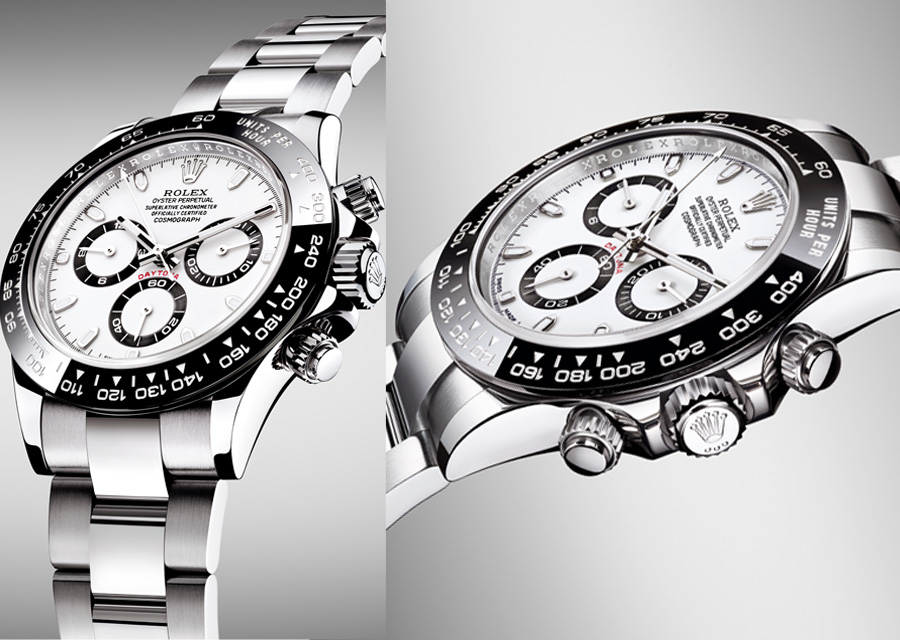
This innovative Cerachrom bezel, developed and patented by Rolex, offers a number of advantages. Its hardness makes it virtually scratchproof, it keeps its colour despite the effects of UV rays and it is corrosion-resistant. In addition to this extreme durability, the numerals on the tachymetric scale are exceptionally legible, thanks to a process developed by Rolex.
The graduations are first moulded in the ceramic before it is fired at 1,500° C, then coated with a thin layer of platinum via PVD (Physical Vapour Deposition). The clear definition obtained through this process, together with the contrast of the platinum against the black ceramic, lends peerless legibility to the bezel of the 2016 Daytona.
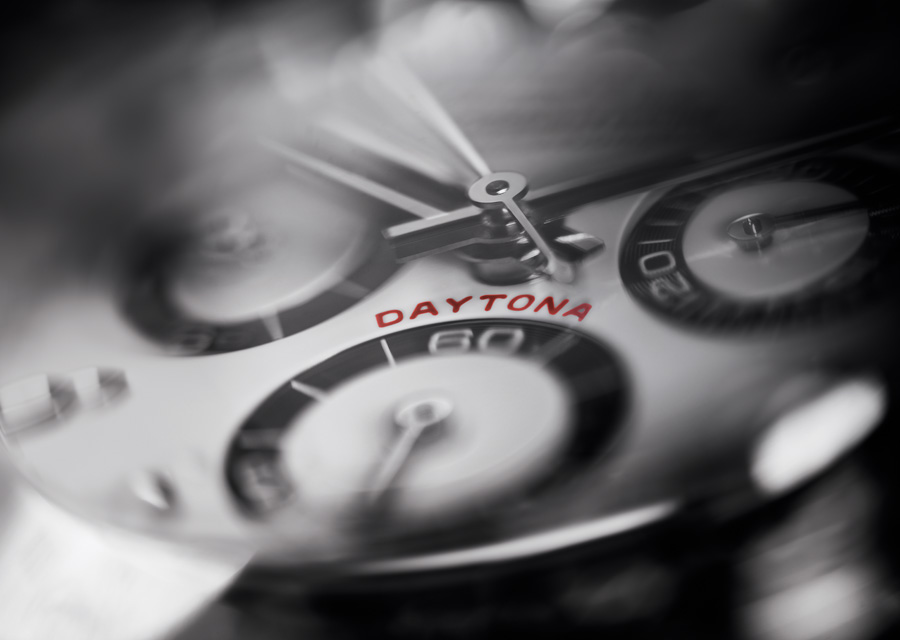
The design of the graduations has also evolved with numerals and triangular markers around the edge of the bezel. The monobloc Cerachrom bezel is made in a single piece and holds the crystal firmly in place on the middle case, ensuring waterproofness. This exclusive component first appeared in 2011 on an 18 ct Everose gold Daytona before being fitted in 2013 on the 950 platinum version celebrating the Cosmograph Daytona’s 50th anniversary.
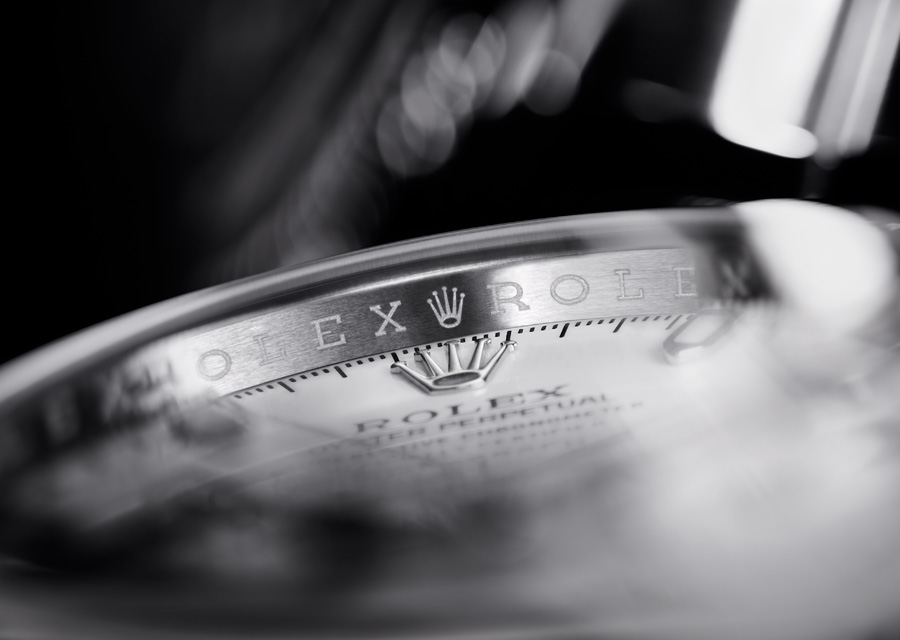
THE LEGEND
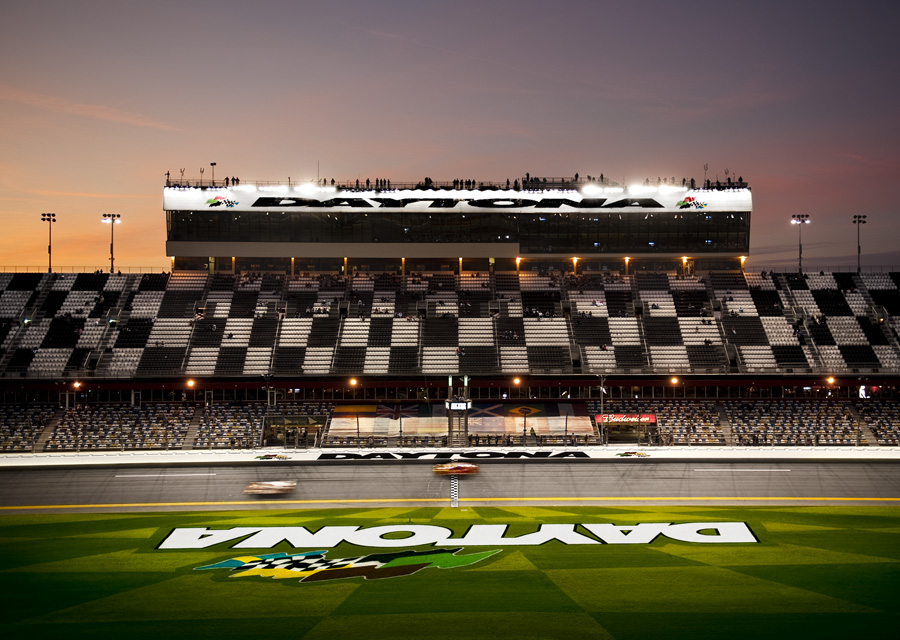
Whether it refers to the place in Florida – the birthplace of speed, the eponymous racing circuit and the endurance race held there today – or the emblematic Rolex chronograph dedicated to racing drivers, the name Daytona tells the story of a passion for motor racing. It is at the heart of a legend forged over time by the pioneers of speed and great drivers. Each of these historic figures testifies to the long-standing and privileged ties that Rolex has fostered with the world of motor racing.
1935 – SIR MALCOLM CAMPBELL KING OF SPEED
Sir Malcolm Campbell broke the world land speed record nine times between 1924 and 1935, setting five of them on the beach at Daytona. He also set four world water speed records. Known as the “King of Speed”, knighted by King George V for his feats, in 1935 Sir Malcolm became the ?rst man to break 300 mph (482 km/h) at the wheel of his famous Bluebird on the Bonneville Salt Flats. From 1930 onwards, Campbell had been wearing a Rolex Oyster, and it was on his wrist during this record-breaking exploit. He thus became the first Rolex Testimonee in motor sport.
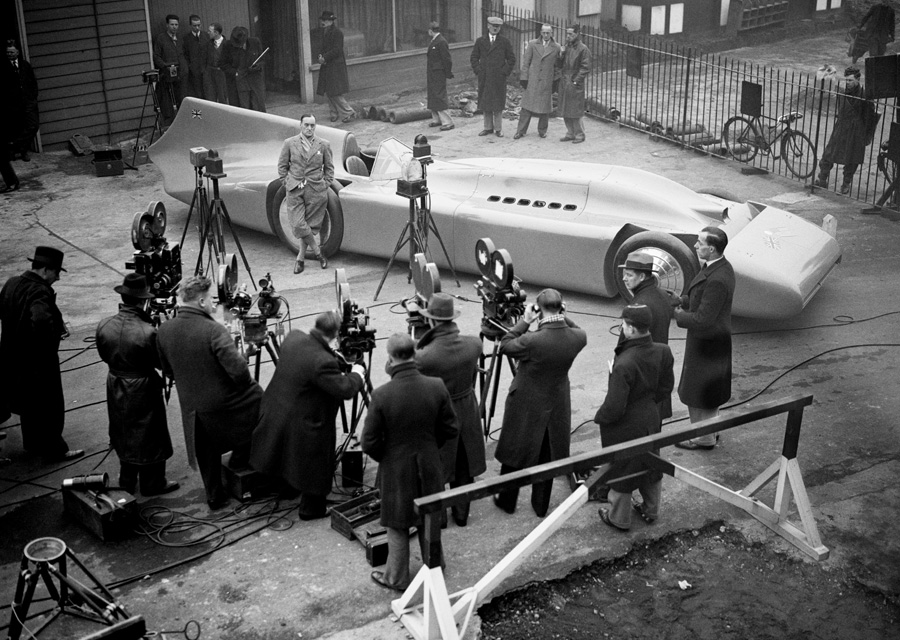
1962 – DAN GURNEY FIRST DAYTONA ENDURANCE WINNER
In 1962, Dan Gurney won the first edition of the Daytona Continental – later to become the Rolex 24 At Daytona. A spectacular victory after what was the slowest finish in history. Dan Gurney had been in the lead throughout but his engine failed 1 minute 40 seconds before the end of the race just short of the finish line. He stopped the car, checked his watch, waited a few seconds for the fiag to come down, then released the handbrake and, making use of the banking, coasted over the line after the regulatory time had passed, to claim victory.
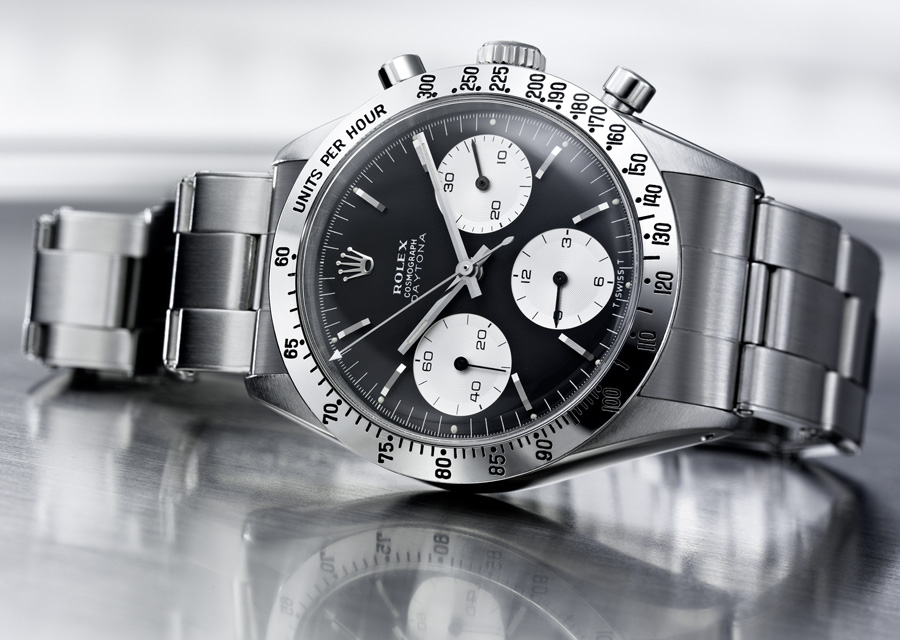
Five years later in 1967, this legendary driver, with a number of victories also to his name in F1, sports car, NASCAR and IndyCar racing, introduced one of the great traditions to motor sport. After his victory in the 24 Hours of Le Mans, Gurney, a teetotaler, shook the bottle he had just received, spraying all the people on the podium with champagne. The photos immortalizing the moment show Gurney wearing his Rolex Datejust. Returning to Daytona in 2008, as Grand Marshal of the Rolex 24 At Daytona, Dan Gurney gave the signal to start the race.
1968 – VIC ELFORD WINNING ALL-ROUNDER
British racer Vic Elford entered into automobile legend as one of the fastest and most accomplished all-round drivers of the 1960s and 1970s. In 1968, he won the Rolex 24 At Daytona and received the Cosmograph Daytona traditionally offered to the winner. He had a good year: a few weeks previously, he had triumphed at the Monte-Carlo Rally and, a month after Daytona, he finished second at Sebring. May brought a win at the Targa Florio endurance race in Sicily, followed by another two weeks later at the Nürburgring 1000 km in Germany. He came fourth in his first F1 Grand Prix, in France. At the 24 Hours of Le Mans in 1972, he stopped to save another driver after a serious accident, a deed for which he was awarded the Chevalier of the National Order of Merit by the French President. Nicknamed “Quick Vic” by his fellow racing drivers, this exceptional driver officiated as Grand Marshal at the 2010 edition of the Rolex 24 At Daytona.
1969 – SIR JACKIE STEWART ACE AT THE WHEEL
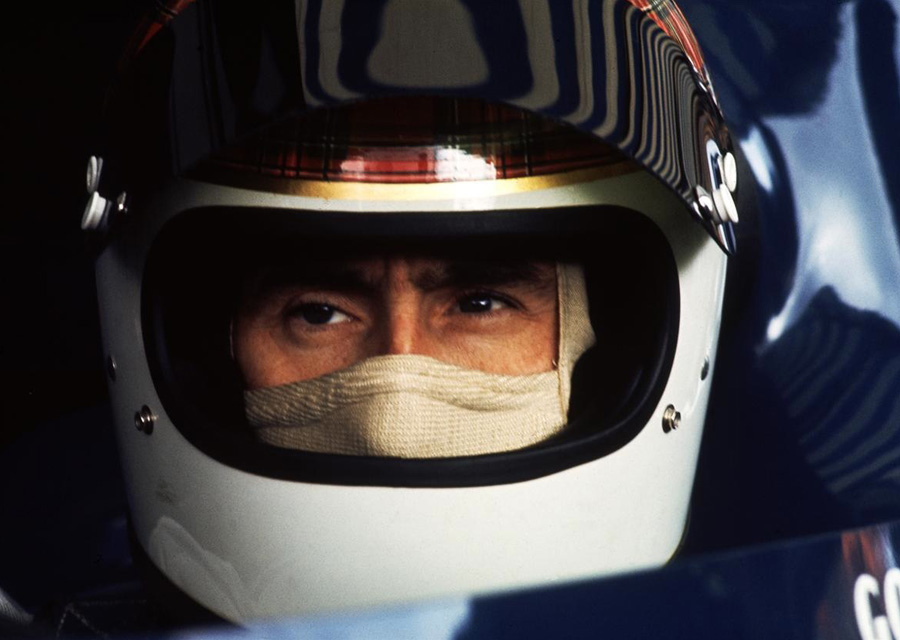
Born in Scotland in 1939, Sir Jackie Stewart is undoubtedly one of the most emblematic figures of contemporary motor racing. His achievements make him one of the most celebrated Formula 1 drivers of the last 40 years. His determined commitment to driver safety has significantly changed the face of motor sports and contributed to making him a true “gentleman driver”. Sir Jackie Stewart took part in 99 Formula 1 Grand Prix races, winning 27, carrying off three world championships (1969, 1971 and 1973) and finishing 43 times on the podium. He has been a Rolex Testimonee since 1969. In tribute to his status in motor sport, in 2012 he was Grand Marshal of the 50th anniversary edition of the Rolex 24 At Daytona.
1972 – PAUL NEWMAN ACTOR AND PASSIONATE DRIVER
The Figure of Paul Newman will forever be linked to the legend of the Cosmograph Daytona. For decades from the 1970s on, the legendary Hollywood star and passionate racing car driver wore a Cosmograph Daytona in town as well as on the race track – a model with a particular dial, which collectors would associate both with his name and his aura. The dial featured a seconds track on a band of the same contrasting colour as the three counters. The counters themselves were characterized by squares on the markers to facilitate reading.
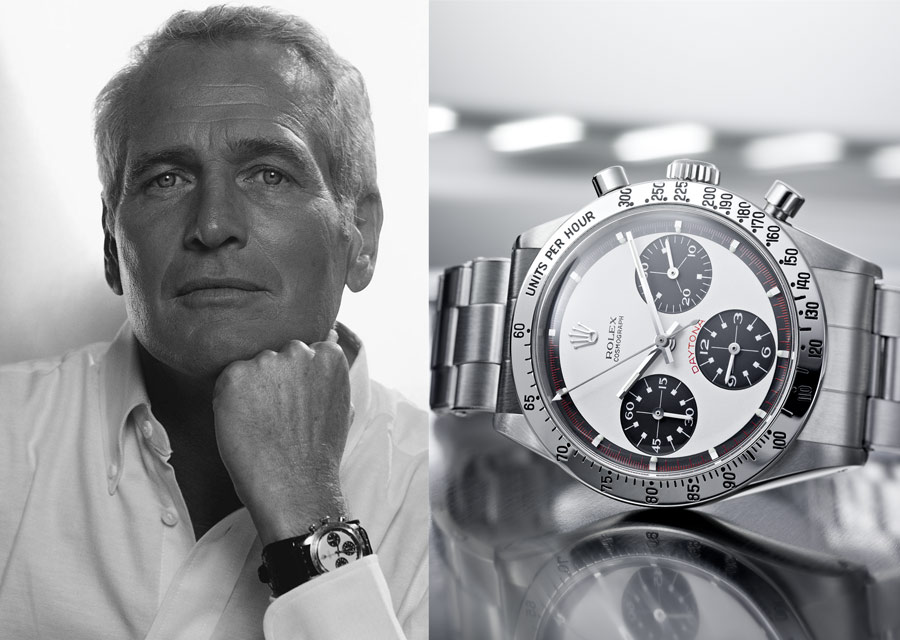
1973 – HURLEY HAYWOOD DAYTONA’S MOST TITLED CHAMPION
Five victories in the Rolex 24 At Daytona, three at the 24 Hours of Le Mans and two at the 12 Hours of Sebring; Hurley Haywood is recognized as one of the most accomplished endurance racing drivers. He is also the most titled champion at Daytona, which he won for the first time in 1973. Hurley Haywood is famous for having said: “If you have one ounce of energy left, then you haven’t done your job properly”. In 1977, he accomplished a feat at Daytona by driving for eight hours non-stop after his two teammates refused to drive at night. And he won the race. Several months later, he won the 24 Hours of Le Mans, and became the ?rst driver to claim the legendary double win.
For Haywood, Daytona is the most difficult of the three famed endurance races, mainly because of the long January night (12 hours versus the Le Mans’ Five-hour summer night), the great number of cars running on a shorter circuit with three distinct classes of competitors together. In 2012, at the age of 64, Hurley Haywood brought his racing career to a grand finish by competing in the 50th anniversary edition of the Rolex 24 At Daytona – his 40th participation. In 2013, he stepped to the other side of the line at Daytona as Grand Marshal, giving the start to the race – with a Cosmograph Daytona on his wrist. “This watch represents the insignia of victory every racing driver dreams of.”
1992 – ROLEX 24 AT DAYTONA NON-STOP RACING
Considered one of the most prestigious endurance car races in the world, the Rolex 24 At Daytona is held at the Daytona International Speedway in Florida and runs non-stop for over 24 hours, almost 12 of them at night. The only contest of its kind in North America, followed by tens of thousands of enthusiastic spectators, the race celebrated its 50th anniversary in 2012. The best drivers in the world gather here aiming for victory and, in so doing, competing for a Cosmograph Daytona, the legendary trophy of the Rolex 24 At Daytona. Rolex has been associated with the Daytona International Speedway since 1959 and Title Sponsor of the race since 1992.
2001 – THE 24 HOURS OF LE MANS STERN TEST OF ENDURANCE
Created in 1923, the 24 Hours of Le Mans is the oldest and one of the most prestigious endurance car races in the world. The year 2013 marks the race’s 80th edition. A stern test of the reliability of the machines as well as the physical and mental stamina of the drivers, Le Mans attracts some of the greatest names in motor sport. On the 13.5-kilometre course, some 50 cars, each with teams of three drivers, race against each other, divided into two categories: the Le Mans Prototypes and the GT cars. The winners are the team that covers the greatest distance in 24 hours, some 5,000 kilometres. Rolex has been Official Timepiece of the race since 2001.
2004 – GOODWOOD REVIVAL NOSTALGIA OF YESTERYEAR
The Goodwood Revival is a three-day festival held each September. It is one of the world’s most popular motor racing meetings and the only UK event that recreates the golden era of motor sport, from the 1950s and 1960s, with vintage cars, legendary drivers, music and clothing of that era. The festival acts as a showcase for exceptional wheel-to-wheel racing around a classic circuit and relives the glory days of the Goodwood Motor Racing Circuit, which ranked alongside Silverstone as Britain’s leading racing venue throughout its active years. Rolex has been a partner of the Goodwood Revival since 2004.
2010 – TOM KRISTENSEN RECORD-SETTING ENDURANCE
Having clocked up nine victories at the 24 Hours of Le Mans between 1997 and 2013 – including six consecutive wins from 2000 to 2005 – the Danish racing driver holds a record number of successes in the oldest and one of the most prestigious automobile endurance races in the world. Dubbed “Mr Le Mans”, this emblematic figure in the sport also triumphed six times at the 12 Hours of Sebring, held each year in Florida. A Rolex Testimonee since 2010, Tom Kristensen was endurance racing’s World Champion in 2013 and officiated as Grand Marshal at the 2016 Rolex 24 At Daytona®.
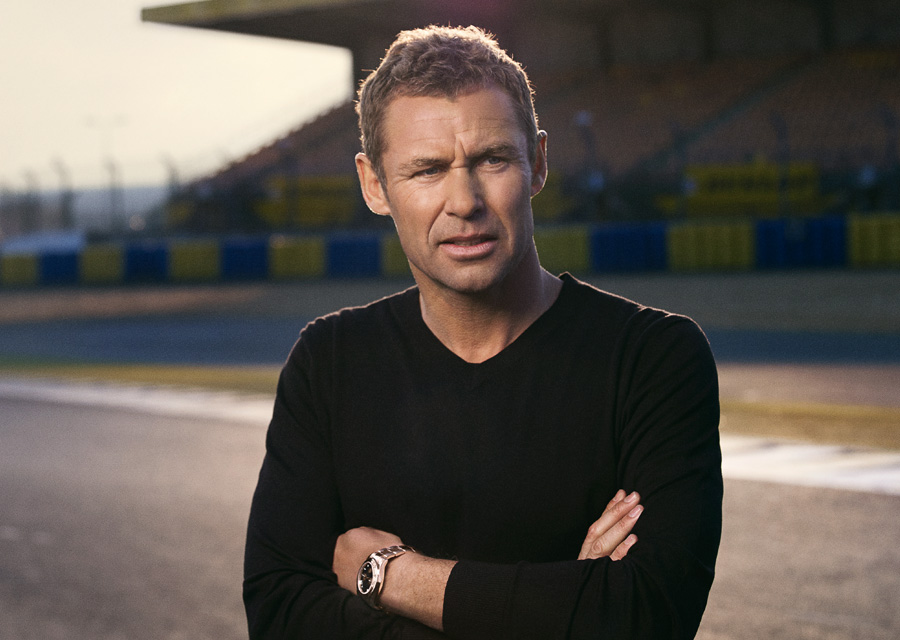
“Motor sports is all about getting the best out of your machine through optimization and technology, and anyone who is interested in that is also interested in mechanical watches,” says Tom Kristensen. “Ask anyone in the motor sports world to name a watch and the first to be mentioned is bound to be the Rolex Cosmograph Daytona… The Rolex Cosmograph Daytona has a history and class around it that everyone trying to aim for the top in motor sport understands and respects. Each driver wants to win ‘his’ Rolex Daytona.”
2013 – FORMULA 1 GLOBAL PARTNER AND OFFICIAL TIMEPIECE
Rolex has forged a major long-term partnership with Formula 1 from 2013 as Global Partner and Official Timepiece. This reinforces Rolex’s commitment to motor racing and its support of global sport at the very highest level. This new partnership with the pinnacle of motor sports brings together two leaders in their fields who share a passion for performance, precision, excellence and innovation. It is part of a strategic move by Rolex to focus its sponsorship activities on ventures chosen for their strong symbolic value and their global resonance. Rolex also became Title Sponsor of the 2013 Australian Grand Prix, the First race of the F1 season.
2013 – SCOTT PRUETT A LEGEND IN THE MAKING
After winning his fifth Rolex 24 At Daytona victory in 2013, Scott Pruett has equalled the record Hurley Haywood held for more than 20 years and has entered into the annals of motor racing. With each of those victories, he has won a Cosmograph Daytona engraved on the case back with the date, the race logo and the magical word: “Winner”. “It’s all about the watch,” he said, talking about the trophy coveted by all drivers.
2014–2015 – BLOODHOUND OBJECTIVE 1,000 MPH
The Bloodhound SSC project is preparing to break the world land speed record by 2015 with a cutting-edge, jet- and rocket-powered supersonic car capable of achieving the speed of 1,000 mph (1,600 km/h). Driven by a record-breaking heritage and the adventurer’s determination to “confront and overcome the impossible”, the British team behind Bloodhound is also aiming to encourage future generations of scientists and engineers. Rolex joined the Bloodhound SSC World Land Speed Record project in 2011, perpetuating the brand’s long-standing presence at the frontiers of speed.